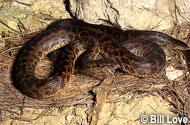Description:
A pair of Childrenâ€'s pythons may be maintained in a 20 to 30 gallon capacity terrarium. The substrate may be of fallen oak and maple leaves, folded newspaper, several thicknesses of paper towels, aspen shavings or cypress shavings. Hiding areas in the form of small hollow logs, cholla cactus skeletons or plastic hide-boxes are placed in each cage. A water bowl sufficiently large for the pythons to both drink and soak is provided. The water must be kept fresh and clean. Daytime illumination is provided and a small undertank heater runs all the time. A flat rock sits atop the heater and the pythons often lie quietly on top of the rock, especially for a few days following their prekilled mouse repast. The temperature on the surface of the rock is about 99 degrees Fahrenheit while the rest of the tank is about 80 degrees in the summer and 74 degrees in the winter. Of their own volition Children’s pythons often choose to miss a meal during the cooler winter months and just as a matter of course the size of the prey item and the frequency with which the snakes are fed is reduced while the tank temperature is cooled. Adults of the Children’s python are easily fed. They will eat adult mice or rat pups. Hatchlings may initially be reluctant feeders but they usually eagerly accept pinky mice. Scenting a pinky mouse with a lizard will often induce a holdout to accept the prey. These pythons produce few, but large, eggs. A clutch usually contains 5 to 8 eggs. Heavily gravid females of this genus have the disconcerting habit of lying belly-up. If unfamiliar with this habit, an owner may think the snake is ill and become unnecessarily concerned. At 84 to 88 degrees fertile eggs will hatch in from 55 to 65 days. The hatchlings often remain in the eggs for several hours to two days after pipping. Hatchlings are from 8½ to 10½ inches in length.
Habitat:
A habitat generalist, the Childrenâs python may be encountered in monsoon forest, dry forests and scrublands. It is often seen near piles of vegetational debris, boulder fields and creviced escarpments.
Range:
This snake is found in tropical Northern Australia west of Cape York, Queensland.
Scientific Name: Antaresia childreni
Species Group: python
Family: Pythonidae
Size: The Children's Python Antaresia childreni attains an adult length of 36 to 40 inches.
Level: beginner
Weight:
Dangerous: No



